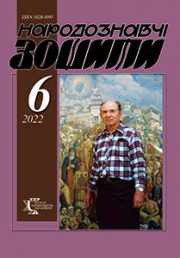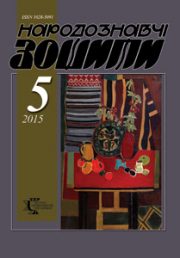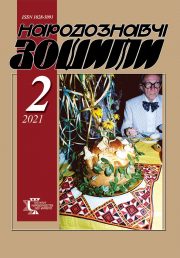The Ethnology Notebooks. 2022. № 3 (165), 664—673
UDK 392:392.12:477.86/.87
DOI https://doi.org/10.15407/nz2022.03.664
ANCIETARY CUSTOMS AND RITUALS OF UKRAINIANS OF OPILLYA AND BOYKIVSCHINA
DENYS Iryna
- ORCID ID: https://orcid.org/0000-0001-9646-2100
- Candidate of Historical Sciences,
- Associate Professor,
- Ukrainian National Forestry University,
- Department of Philosophy, Sociology and Cultural Studies,
- 103, General Chuprynky Street, Lviv, 79057, Ukraine,
- Contacts: e-mail: idenys15@gmail.com
VOITOVYCH Nadiia
- ORCID ID: https://orcid.org/0000-0001-6313-9585
- Candidate of Historical Sciences,
- Associate Professor,
- Stepan Gzhytskyi National University of Veterinary
- Medicine and Biotechnologies,
- Department of the History of Ukraine, Economic Theory and Tourism,
- 50, Pekarska Street, Lviv, 79000, Ukraine,
- Contacts: е-mail: wojtovych@ukr.net
Abstract. From ancient times in the minds of Ukrainians the image of a woman is closely associated with the guardian of the family, home comfort and well-being, as evidenced by various Ukrainian proverbs and sayings: «A man in the house — the head and a woman — the soul», «A woman holds a house by three corners, and a man by one…», «Like a hen with chickens, and a woman with children», etc. That is why the figure of the Ukrainian woman as a mother, as a good/bad wife, daughter-in-law or daughter, and on the other hand, as an independent strong person is always relevant for researchers.
Our study focuses on the figure of a pregnant woman, in particular the attitude of Ukrainians to pregnant woman in the historical and ethnographic areas of Opillya and Boykivshchyna, analyzed the antenatal customs and rites of opillians and boykos, revealing common and distinctive features in folk beliefs about pregnancy, birth process and protection of the newborn baby.
The birth of a newborn has always been a significant event in every family. And this is natural, because the family is replenished with a new member, with whom parents and relatives have certain hopes and expectations. Antenatal rites of the inhabitants of Opillya and Boykivshchyna from the end of XIX — beginning of XXI centuries is always relevant and an integral part of the spiritual culture of Ukrainians, because it is a system of diverse customs and beliefs, in which the rational is closely intertwined with the magical and religious аnd Christian.
The research methodology is based on the use of the principles of historicism, systematicity, scientificity, verification, authorial objectivity, as well as on the application of comparative-historical, structural-functional, statistical, deductive methods, typological and complex analysis. The scientific novelty of the work is that for the first time in Ukrainian historiography and ethnology a study of antenatal customs and rituals of the inhabitants of Opillya and Boykivshchyna from the end of XIX to the beginning of XXI centuries.
Keywords: maternity rites, antenatal customs and rites, folk beliefs, pregnant woman, baby, Opillya, Boykivshchyna.
Received 17.06.2022
REFERENCES
- Sumtsov, N.F. (1918). Slobozhane: historical and ethnographic exploration. Kharkiv: Union. Kharkiv. Credit. Union Cooperative [in Ukrainian].
- Hrushevsky, M., & Kuzel, Z. (1906, 1907). The child in the customs and beliefs of the Ukrainian people. Materials from the southern Kyiv region. Materials on Ukrainian-Russian ethnology (Vol. 8, 9). Lviv [in Ukrainian].
- Kuzelya, Z. (1906). The child in the customs and beliefs of the Ukrainian people. Materials from the southern Kyiv region. Materials on Ukrainian-Russian ethnology (Vol. 8). Lviv [in Ukrainian].
- Vovk, Kh. (1995). Maternity rites. Studies in Ukrainian ethnography and anthropology (Pp. 192—195). Kyiv: Art [in Ukrainian].
- Onishchuk, A. (1912). From the folk life of the Hutsuls. Families and baptisms and a child up to the sixth year of life. Materials on Ukrainian ethnology (Vol. 15, pp. 90—158). Lviv [in Ukrainian].
- Kravchenko, V. (1920). Customs in the village of Zabriddya and some other, not far from this village areas of Zhytomyr County in Volyn. Zhytomyr [in Ukrainian].
- Hrushevsky, M. (1926). Haircuts and other rites performed on children and adolescents. Primitive citizenship and its remnants in Ukraine (Issue 1—2, pp. 83—86) [in Ukrainian].
- Zaglada, N. (1929). Life of a peasant child. Materials for the monograph v. Starosillya. Kyiv [in Ukrainian].
- Gavrilyuk, N.K. (1981). Mapping of the phenomena of spiritual culture (according to the materials of the maternity rites of Ukrainians). Kyiv [in Ukrainian].
- Syavavko, Ye.I. (1974). Ukrainian ethnopedagogy in its historical development. Kyiv: Naukova dumka [in Ukrainian].
- Stelmakhovych, M.G. (1996). Ukrainian family pedagogy. Kyiv: ISDO [in Ukrainian].
- Boltarovich, Z.Ye. (1990). Folk medicine of Ukrainians. Kyiv: Naukova dumka [in Ukrainian].
- Hannusenko, N. & Matseykiv, T. (1996). From the national treasury: (The role of the family in the development, education and formation of personality). Native school, 11—12, 31—34 [in Ukrainian].
- Borisenko, V., & Ponomarev, A.P. (1994). Maternity customs and rituals. Podillya: historical and ethnographic research (Pp. 211—217). Kyiv: Vid-vo Nezaleznoho kulturnoho centru «Dolya» [in Ukrainian].
- Gvozdevych, S. (1995). Water and fire in the maternity rites of Ukrainians XIX — early XX century. Ethnographic notebooks, 1, 34—35; Gvozdevych, S. (1997). Maternity rites of Ukrainians of the Carpathians. Ethnographic notebooks, 2, 111—122; Gvozdevych, S., Pavlyuk, S., & Glushko, M. (2 eds.). (1998). Some aspects of prenatal customs and rituals of Ukrainians in the Carpathians. Ethnographic notebooks, 3, 278—280; Gvozdevych, S. (1999). Maternity rites of Polishchuks of Ovruch region. Polissya of Ukraine: materials of historical and ethnographic research (Issue 2, pp. 185—190: Ovruchchyna, 1995). Lviv: Institute of Ethnology of the National Academy of Sciences of Ukraine; Gvozdevych, S., Goshko, Ju., & Pavlyuk, S. (2 eds.). (2002). Maternity customs and rites. Lemkivshchyna: historical and ethnographic research: in 2 vol. Lviv, 1999. Spiritual culture (Vol. 2, pp. 64—74). Lviv: Institute of Ethnology of the National Academy of Sciences of Ukraine [in Ukrainian].
- Gavrilyuk, N., & Orel, L. (2000). The birth of a child. Ukrainian family: family and public life. Kyiv: Vid-vo O. Teliga [in Ukrainian].
- Kramar, R., & Orel, L. (2000). Maternity and baptismal customs of the Galician Podillya. Ukrainian family: family and public life (Pp. 83—89). Kyiv: Vid-vo O. Teliga [in Ukrainian].
- Nesen, I., & Orel, L. (2000). Families and baptisms in the south of Volhynia. Ukrainian family: family and public life (P. 88—92). Kyiv: Vid-vo O. Teliga [in Ukrainian].
- Gayova, Ye., & Orel, L. (2000). The child in the rites and customs of Mukachevo. Ukrainian family: family and public life (Pp. 92—97). Kyiv: Vid-vo O. Teliga [in Ukrainian].
- Pankiv, M. (1997). Maternity rites and child care in Pokuttia (late nineteenth — early twentieth century). Yamgoriv: lit.-krayezn. and artist. Almanach, 9—10, 138—149 [in Ukrainian].
- Mandebura-Noga, O. (2002). People: beliefs, customs, rites of Polishchuks (according to expeditionary materials). Ethnic history of the peoples of Europe: a collection of scientific papers (Issue 13, pp. 46—52). Kyiv: UNISERV [in Ukrainian].
- Pidtserkovna, Ja. (2003). Institute of nepotism in Western Polissya (based on materials from the villages of Kostopil and Goshchansky districts of Rivne region). Ethnocultural heritage of Rivne Polissya (Issue III, pp. 28—34). Rivne: Perspective [in Ukrainian].
- Kondratovych, O. (2007). Ukrainian customs: peoples. My braid… Lutsk: Volynska oblasna drukarnya [in Ukrainian].
- Nebesna, Z. (2010). Customs at the birth of a child in Boykivshchyna. Dynamics of changes in rituals of the XX—XXI centuries. Folk art and ethnography, 6, 40—46 [in Ukrainian].
- Manuscript funds of the M. Rylsky Institute of Art History, Folklore and Ethnology of the National Academy of Sciences of Ukraine. F. 1—6. Od. coll. 621. Arc. 61 [in Ukrainian].
- Syavavko, Ye.I., & Goshko, Yu.I. (Ed.). (1987). Family rituals. Hutsul region: historical and ethnographic research. Kyiv: Naukova dumka [in Ukrainian].
- Khanas, I. Materials of the ethnographic expedition. Archive of the Institute of Ethnology of the National Academy of Sciences of Ukraine. F. 1. Op. 2. Ref. 571 (Dod. A) [in Ukrainian].
- Piskach, O. (2011). Action and nominative aspects of maternity rites in the dialects of Mizhhirya district of Zakarpattia region. Scientific Bulletin of Uzhgorod University. Series: Philology. Social communications (Issue 24) [in Ukrainian].
- Mushinka, M. (1988). South. Spiritual culture. Lemko region, land, people, history, culture (Part II: Notes of the T. Shevchenko Scientific Society). Historical and Philosophical Section (Vol. 206). New York; Paris; Sydney; Toronto [in Ukrainian].
- Zhatkovich, Yu. (1896). Ethnographic notes from Hungarian Ruthenia. Ethnographic collection of NTSh (Volume II, p. 20). Lviv [in Ukrainian].
- Talko-Hryncewicz, J. (1983). Zarysy lecznictwa ludovego na Rusi (Pp. 66—67). Krakow [in Polish].
- Archive of the Institute of National Academy of Sciences of Ukraine. F. I. Op. 2. Od. coll. 344 [in Ukrainian].
- Archive of Ivan Franko of the National University of Lviv. F. 119. Op. 17. Ref. 216-E [in Ukrainian].
- (2007). Holy Gospel of Matthew. The Holy Scriptures of the Old and New Testaments. Missionary Fathers Publishing House [in Ukrainian].
- Archive of the Institute of the National Academy of Sciences of Ukraine. F. I. Op. 2. Od. coll. 350 [in Ukrainian].
- Archive of the Institute of the National Academy of Sciences of Ukraine. F. I. Op. 2. Od. coll. 350 a [in Ukrainian].
- Franko, I. (1898). People’s beliefs in the foothills. Ethnographic collection (Issue V) [in Ukrainian].
- Kayndl, R.F. (2000). Hutsuls: their lives, customs and folk tales. Chernivtsi: Molodiy bukovinec [in Ukrainian].
- Gerasimovych, V. (1894). Folk customs, rituals and songs in the village of Krekhiv, Zhovkva district. Truth (Vol. 20, issue 59) [in Ukrainian].







